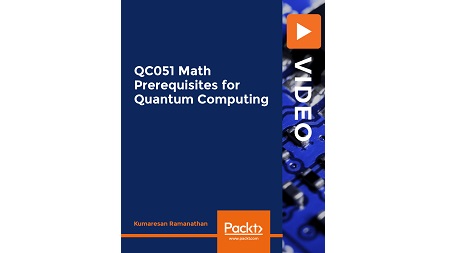
English | MP4 | AVC 1280×720 | AAC 44KHz 2ch | 4h 12m | 367 MB
Review basic math prerequisites for quantum computing and quantum physics
This is a refresher course in Mathematics for students who studied Math and Physics through 12th grade at high school but have now forgotten many of the details. In fewer than 4 hours, this course reviews the Math you will need to understand quantum computing concepts.
The focus is on getting you up-to-speed as quickly as possible. This covers only what you need to know: probability, statistics, Boolean logic, complex numbers, and linear algebra. You will not waste time on topics you do not need for quantum computing.
To get the most out of this course, you need to have already studied Math at a 12th-grade level in high school. This is merely a review course to help you refresh your memory. If you have not studied these topics in high school, then this 4-hour course is no substitute for 2 years of high school Math classes.
This course reviews basic high-school Math. It doesn’t go into any details about quantum physics or quantum computing.
Learn
- A Math foundation for learning about quantum computing: probability, statistics, Boolean logic, complex numbers, and linear algebra.
Table of Contents
Boolean Algebra
1 Introduction
2 Boolean Algebra
3 Boolean Variables & Operators
4 Truth Tables
5 Logic Gates
6 Logic Circuits
7 AND Gate
8 OR Gate
9 NOT Gate
10 Multiple Input Gates
11 Equivalent Circuits 1
12 Equivalent Circuits 2
13 Universal Gate – NAND
14 Exclusive-OR
15 XOR for Assignment
16 XOR of Bit Sequences 1
17 XOR of Bit Sequences 2
Cryptography
18 Introduction to Cryptography
19 Cryptography with XOR
20 Shared Secret
21 Importance of Randomness
22 Breaking the Code
Probability
23 Introduction to Probability
24 Probability of a Boolean Expression
25 Mutually Exclusive Events
26 Independent Events
27 Manipulating Probabilities with Algebra
28 P (Mutually Exclusive Events )
29 P (Independent Events )
30 Complete Set of Mutually Exclusive Events
31 P (A OR B )
32 Examples
33 Examples
34 P (Bit Values )
35 Analysis with Venn Diagrams
36 Venn Diagram P (A AND B )
37 Venn Diagram P (A OR B )
38 Venn Diagram P (NOT A )
39 Examples
40 Examples
41 Conditional Probability
42 Examples
Statistics
43 Introduction to Statistics
44 Random Variables
45 Mapping Random Variables
46 Mean, Average, Expected Value …
47 Example
48 Example
49 Beyond Mean
50 Standard Deviation
51 Examples
52 Combinations of Random Variables
53 Correlation
54 Analysis of Correlation
Complex Numbers
55 Introduction to Complex Numbers
56 Imaginary i
57 Addition
58 Subtraction
59 Multiplication by a Real
60 Division by a Real
61 Complex Multiplication
62 Examples
63 Complex Conjugates
64 Squared Magnitude
65 Complex Division
66 Examples
67 Euler’s Formula
68 Polar Form
69 Examples
70 Fractional Powers
71 Complex Cube Roots of 1
72 Square Root of i
73 D Coordinates
Linear Algebra & Matrices
74 Matrices
75 Matrix Dimensions
76 Matrix Addition
77 Subtraction
78 Scalar Multiplication
79 Matrix Multiplication
80 Examples
81 Examples
82 x3 Example
83 Exercises
84 More Multiplications
85 When is Multiplication Possible
86 Example
87 Not Commutative
88 Associative & Distributive
89 Dimension of Result
90 Odd Shaped Matrices
91 Examples
92 Outer Product
93 Exercise
94 Inner Product
95 Exercises
96 Identity Matrix
97 Matrix Inverse
98 Transpose
99 Transpose Examples
100 Transpose of Product
101 Complex Conjugate of Matrices
102 Adjoint
103 Unitary
104 Hermitian
105 Hermitian & Unitary
106 Why Hermitian or Unitary
107 Vectors & Transformations
108 Rotation in 2D
109 Special Directions
110 Eigen Vectors & Eigen Values
111 More Eigen Vectors
112 Conclusion
Resolve the captcha to access the links!